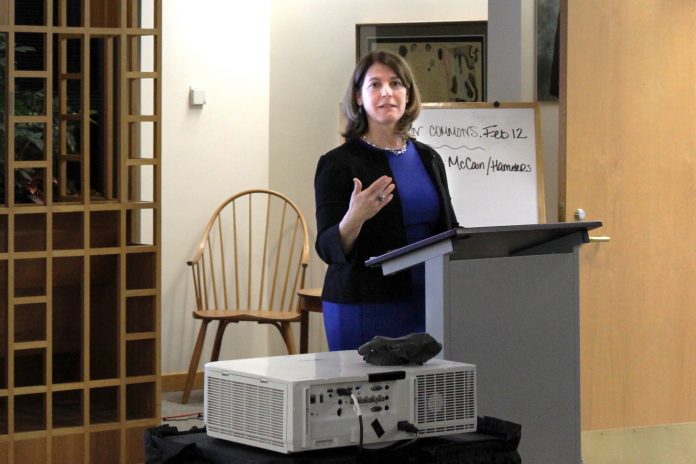On Tuesday, Feb. 12 at 7 p.m. in the Trexler Library, Muhlenberg welcomed Cathleen D. Cahill to campus to deliver a lecture titled “Who Was a Suffragist? A More Diverse View.” An associate professor of History at Pennsylvania State University, Cahill is also currently working on her own book, Authors of Federal Fathers and Mothers.
“Who Was a Suffragist?” is the second of Muhlenberg’s History Lecture series, “A Century of Struggle: Women’s Rights Before and After Suffrage” to happen on campus. Assistant professor of History Jacqueline Antonovich introduced Cahill and expressed gratitude that there is a “widespread interest in these topics” at the College.
Cahill started the lecture by providing audience members with a Google search of the term “suffragist,” shockingly revealing that all of the pictures that came up as a result depicted white women. With a main focus on the advances made by women of color during the suffrage movement, Cahill divided her lecture into three main parts: Part I: Our Sisters in China, Part II: The Color Line and Part III: Considering 1920. Delving into the history of women such as Mabel Ping-Hua Lee, Nina Otero-Warren and Ida B. Wells-Barnett, the lecture illuminated the fact that stories of women of color are often overlooked and left out of the historical narrative regarding the fight of gender equality. Cahill focused on the struggle to gain support for women’s suffrage at the state level, and how these women, as well as many others, were impacted by the movement due to their marginalized identities.
“…It is a conversation starter to give everyone further information about women we were never given the privilege to learn about.”
While white women were granted the right to vote in 1920, this was not the case for many minority women. Some of the many discriminations they faced during this time was a lack of education and voting rights. Within the movement, they were forced to the back of parades or barred from marching at all. Cahill wove in the complex stories of multicultural women and experiences of non-white women in explaining these parts of history that are often left out of the history textbooks. Throughout her lecture, Cahill referred back to the 19th Amendment and its implications, with an overall theme of how 1920 did not mark a victorious year for all women.
The event was open to the public, with students and faculty both commenting on their experiences.
The students in attendance seemed to appreciate the new perspective that Cahill offered regarding race and the suffrage movement.
“Cahill’s perspective about how women of color are often grouped together even though they have had different experiences was really interesting,” Maryn Pryor ‘23 noted. “I think a lot of the time white narratives group minorities together because they’re unaware of the difference of experiences between all people. I liked that she brought up stories about black, Chinese, and indigenous women and talked about all of their different perspectives.”
“But focusing on just these women elides a more complicated story that often ignores the racism embedded within the mainstream movement and overlooks the tremendous work done by women of color before and after the ratification of the 19th amendment.”
“When the history department sat down with some of our students to conceptualize this series, we all agreed on one thing: we wanted a series that not only celebrated the centennial of the 19th amendment, but one that complicates it,” Antonovich said.
“The story of the suffrage movement is usually told through the lives of women such as Susan B. Anthony, Elizabeth Cady Stanton and Alice Paul, and these women were, in fact, tremendously influential in the effort to win the vote,” Antonovich said. “But focusing on just these women elides a more complicated story that often ignores the racism embedded within the mainstream movement and overlooks the tremendous work done by women of color before and after the ratification of the 19th amendment. That’s why we thought it was tremendously important to bring Cahill to campus.”
Cahill’s presentation definitely proved insightful, as students feel compelled to carry this conversation forward.
“I felt this talk was important, because, although as Cahill mentioned she does not in any way speak for all women of color during the movement, it is a conversation starter to give everyone further information about women we were never given the privilege to learn about,” said Elizabeth Katchen ‘23.





















